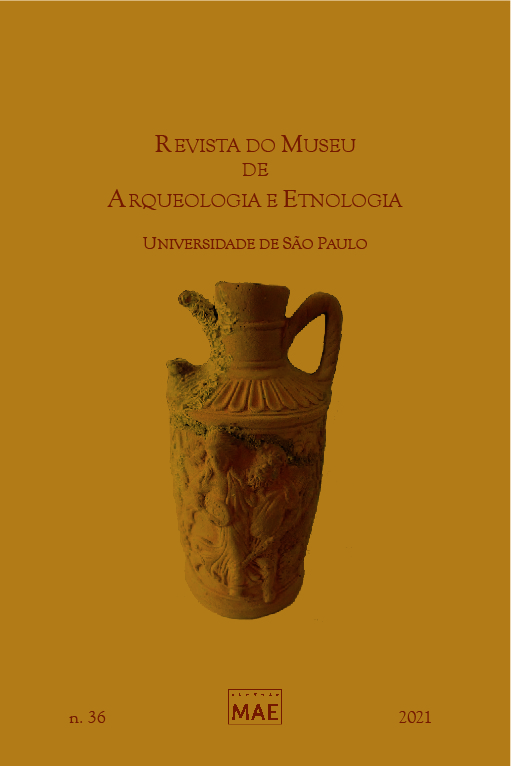The Theatre of Marcellus: historiography and perception of the theatrical space (1st c. BC)
DOI:
https://doi.org/10.11606/issn.2448-1750.revmae.2021.163784Keywords:
Theatre of Marcellus, Theatrical Space, Three-dimensional reconstitutionAbstract
During the transition from the Republic to the Principate, along with arts, literature and architecture, Romes’s urban image was used by Emperor Augustus as an instrument to legitimize the power of his new government and his own image. As Julius Caesar’s heir, the Princeps aimed to modernize the city by building great public monuments. Among these buildings is the Theatre of Marcellus, one of the largest theatres of the Roman Empire. First used in 17 BC for the Secular Games and formally devoted to the Emperor's nephew and heir, the theatre could welcome over 15,000 people. Despite the obvious changes inherent to the passage of time and the restorations performed, the monument structure of the theatre remains. Therefore, deepening in the studies of theatrical physical space, we will pursuit to expose the construction of the Theatre of Marcellus, presenting its internal structure and its architectural innovations. For being this a monument somehow unattended by current historiography, we seek to deliver a broad discussion about the present studies on the Theatre of Marcellus, which provides us with the complexity of its floor plans and archaeological discoveries. Finally, we will present two three-dimensional reproductions found, reasoning the 3D space with the historiographic information.
Downloads
References
Albuquerque, M. 2017. Tecnologias de construção romanas. Disponível em: <https://bit.ly/3jkSAE4>. Acesso em: 02/09/2019.
Athenaeus. 1854. The Deipnosophists. Translated by C. D. Young. Disponível em: <https://bit.ly/3qyZQA6>. Acesso em: 11/02/2020.
Augustus Caesar. 1967. Res Gestae Divi Augusti: The achievements of The Divine Augustus. Oxford University Press, Oxford. Disponível em: <https://bit.ly/3bzNraU>. Acesso em: 20/06/2020.
Berthold, M. 2001. A história mundial do teatro. Perspectiva, São Paulo,.
Brothers, A.J. 1989. Buildings for entertainment. In: Barton, I.M. (Ed.). Roman public buildings. University of Exeter, Exeter.
Buonfiglio, M. 2010. M. E. Blake e lo sviluppo dell’opus testaceum a Roma: il’ caso del Teatro di Marcello. Musila e Sectilla 7: 109-122.
Buonfiglio, M. 2015. L’utilizzo di laterizi nella costruzione augustea del Teatro di Marcello. In: Anais do Workshop Laterizio, Archeologia dell’architecttura, il laterizio nei cantiere imperiali Roma e il Mediterraneo, 2014, Roma.
Calza-Bini, A. 1953. Il teatro di Marcello: forma e strutture. Centro di Studi per la Storia dell’Architettura, Roma.
Checa, A.M. 2005. Sobre los orígenes helenísticos del modelo teatral romano: los primeros teatros em plano de Italia. Revue archéologique 47: 3-51.
Checa, A.M. 2007. La frons scaenae del Theatrum Marcelli según la forma Urbis Marmorea, primeros planteamientos de un problema abierto. Romula 6: 1-74.
Claridge, A. 2010. Roman an Oxford archeological guide. Oxford University Press, New York, 275-276.
Dio Cassius. 1924. Roman History. Harvard University Press, Cambridge, volume 7, books 56-60.
Fidenzoni, P. 1970. Il Teatro di Marcello. Liber, Roma.
Gonçalves, A.T. 2002. As festas imperiais na Roma antiga: os decennalia e os jogos seculares de Septímio Severo. Mneme 3: 16-34.
Grimal, P. 1978. Teatro antigo. Edições 70, Lisboa.
Grimal, P. 2009. As cidades romanas. Edições 70, Lisboa.
Gutiérrez, O.R. 2004. O teatro romano de Itálica: estudio arqueoarquitectónico. Servicio de Publicaciones de la Universidad Autónoma de Madrid, Madrid.
Hines, T.G. 2003. The ancient theatre archive: greekroman theatre glossary. Whitman College, Walla Walla. Disponível em: <https://bit.ly/3m2RM8G>. Acesso em: 24/09/2019.
Kubity. Theatre of Marcellus with tour. 2017. Disponível em: <https://bit.ly/3rMBwfa>. Acesso em: 10/07/2020.
Lugli G. 1957. La tecnica edilizia romana com particolare riguardo a Roma e Lazio. Roma, Bardi Edizioni.
Martins, M. 2008. Espaços, usos e sociabilidade na cidade antiga: contributos e limites da Arqueologia. In: Silva, G.V.; Silva, É.C.M.; Neto, B.M.L. (Orgs.). Usos do espaço no Mundo Antigo. GM., Vitória, 8-11.
Neto, B.M.L. 2018. A arena pública de Cartago como espaço de recuperação da honor de Apuleio de Madaura. In: Silva, G.V.; Silva, É.C.M.; Neto, B.M.L. (Orgs.). Usos do espaço no Mundo Antigo. GM., Vitória, 106-129.
Polybius. 2012. The Histories. Harvard University Press, Cambridge, volume 6, books 28-39, fragments.
Progetto Traiano. 2014. Teatro di Marcello. Disponível em: <https://bit.ly/3kl0rmn>. Acesso em: 02/07/2019.
Richardson, L. 1992. A new topographical dictionary. Johns Hopkins University Press, Baltimore; London, 384-385.
Rose, P. 2005. Spectators and spectator comfort in roman entertainment buildings: a study in functional design. Papers of the British School at Rome 73: 99-130.
Rossetto, P.C.; Buonfiglio, M. 2010. Teatro di Marcello: analise e riflessione sugli aspetti progettuali e costtrutive. In: Anais do 2. Arqueología de la Construcción, Los Procesos Constructivos em el Mundo Romano: Italia e Provincias Orientales, 2010, Siena.
Sánchez, J.G. 2008. Planos de arquitectos españoles publicado en Roma (s. XIX): el Teatro de Marcelo y el Santuario de Hércules Vencedor. Archivo Español de Arqueología 81: 177-200.
Sear, F.B. 2006. Roman theatres: an architectural study. Oxford University Press, Oxford.
Silva, G.V. 2015. Ordem e desordem na cidade antiga: o teatro entre a tradição clássica e cristã. In: Vieira, A.L.B.; Rosa, C.B. (Orgs.). Teatro grego e romano, história, cultura e sociedade. Editora Uema, São Luís, 251-280.
Stanford Digital Forma Urbis Romae Project. Disponível em: <https://stanford.io/2HqgUHk>. Acesso em: 31/01/2019.
Suetonius. 1914. The Lives of the Caesars: Julius. Augustus. Tiberius. Gaius. Caligula. Harvard University Press, Cambridge.
Taub, L. 1993. The historical fuction of the Forma Urbis Romae. Journal Imago Mundi 45: 9-19.
Valentini, R.; Zucchetti, G. 1940. Codice Topografico della città di Roma. Istituto Storico Italiano per il Medio Evo, Rome, volume 1.
Vitrúvio. 2007. Tratado de arquitetura. São Paulo, Martins.
Vitruvius. 1960. The ten books on architecture. New York, Dover Publications.
Wallace-Hadrill, A. 1988. The social structure of the roman house. Papers of the British School at Rome 56: 43-97. Disponível em: <https://bit.ly/2ITwNHh>. Acesso em: 22/07/2020.
Downloads
Published
Issue
Section
License
Copyright (c) 2021 Leticia Aga Pereira Passos

This work is licensed under a Creative Commons Attribution-NonCommercial-NoDerivatives 4.0 International License.













